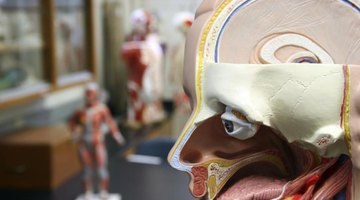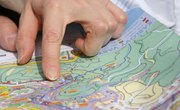Lessons and activities on the brain can enhance a student’s knowledge of human anatomy and spark further interest in learning about the medical sciences. Encourage your students to explore all facets of the brain in your lessons to help them get the most out of their studies.
Parts of the Brain
Create a lesson discussing the parts of a brain. Print out a diagram depicting the brain, enlarging the cerebral hemisphere, cerebellum, midbrain and spinal cord. Give each student a copy of the diagram and instruct each student to label the four parts. Color each portion of the brain a different color to aid in memorization. Print off a cut-away, side view of the brain and paste it on a sheet of card stock. Cut the parts of the brain apart into jigsaw-style pieces and test your students' memories by having them put the brain diagram in order.
Functions of the Brain
Teach students how the brain functions. Set up demonstration tables that enable them to touch specific items, such as listening to a piece of music, tasting a food or liquid or looking at a picture or video clip. At each demonstration table, stand a poster on the table that has a diagram of the brain. Use the same diagram for each poster on each demonstration table. Using a colored marker, highlight on the diagram the specific region of the brain that table is demonstrating. Use differently colored markers for each of the four brain regions you're showing. Use one color for the frontal lobe, which deals with reasoning; use another color for the occipital lobe, which handles the function of vision; use a third color for the temporal lobe, which enables people to hear; and use a fourth color for the parietal lobe near the temples, which interprets the various stimuli presented to the brain. Help students recognize each function of the brain and where the functions are located within the brain's structure. Review the structure of the brain and combine the terms of the brain's functions to help students gain a deeper meaning of how the brain works.
The Brain and Memory
Explore the differences between short-term and long-term memory. Divide the class in half. Allow each group to create a quiz from basic subject material. The questions should be challenging, but not impossible to answer. Administer the quizzes to the other groups. Review the answers and allow the students to take the test again. Explain how the brain uses its short-term memory power to retain the data the students have just learned. Review the test in several days and see how many questions each student answers correctly. The correctly chosen answers demonstrate the brain's ability to retain information.
Protecting the Brain
Create a lesson to demonstrate how the brain is protected in the human body. Wiggle Jello in a bowl to show that the brain is a made of a soft, gelatinous substance that needs protection. Use photographs of a cut-away diagram that will help you show how the hard surface of the skull and the cerebrospinal fluid work together to guard the brain. Using a bicycle or football helmet, tap the helmet to show how the skull is like a helmet that protects the brain. Then, on the diagram, point to the cerebrospinal fluid that cushions the brain from getting slammed or smashed into the side of the skull wall -- much like egg white protects the yolk from the egg shell. Crack raw eggs into a bowl to help visualize the importance of the cerebrospinal fluid that surrounds the brain.
Related Articles
References
Writer Bio
Alyssa Ideboen has been writing professionally since 2005. She has contributed to several print and online publications, including "Lexington Woman" and "Global Business" magazines. Ideboen holds a Bachelor of Arts in business management and communication from Judson University.











